STACKED FOR SUCCESS

A Ground-Level View of Humber Polytechnic’s Capstone Culture
The Shape of Innovation


A Ground-Level View of Humber Polytechnic’s Capstone Culture
The Shape of Innovation
Humber Polytechnic is located within the traditional and treaty lands of the Mississaugas of the Credit. Known as Adoobiigok [A-doe-bee-goke], the “Place of the Alders” in Michi Saagiig [Mi-Chee Saw-Geeg] language, the region is uniquely situated along Humber River Watershed, which historically provided an integral connection for Anishinaabe [Ahnish-nah-bay], Haudenosaunee [Hoeden-no-shownee], and Wendat [Wine-Dot] peoples between the Ontario Lakeshore and the Lake Simcoe/Georgian Bay regions. Now home to people of numerous nations, Adoobiigok continues to provide a vital source of interconnection for all.
Listen to an audio recording of Humber’s Land Acknowledgement (humber.ca/indigenous/truthreconciliation-audio-video)

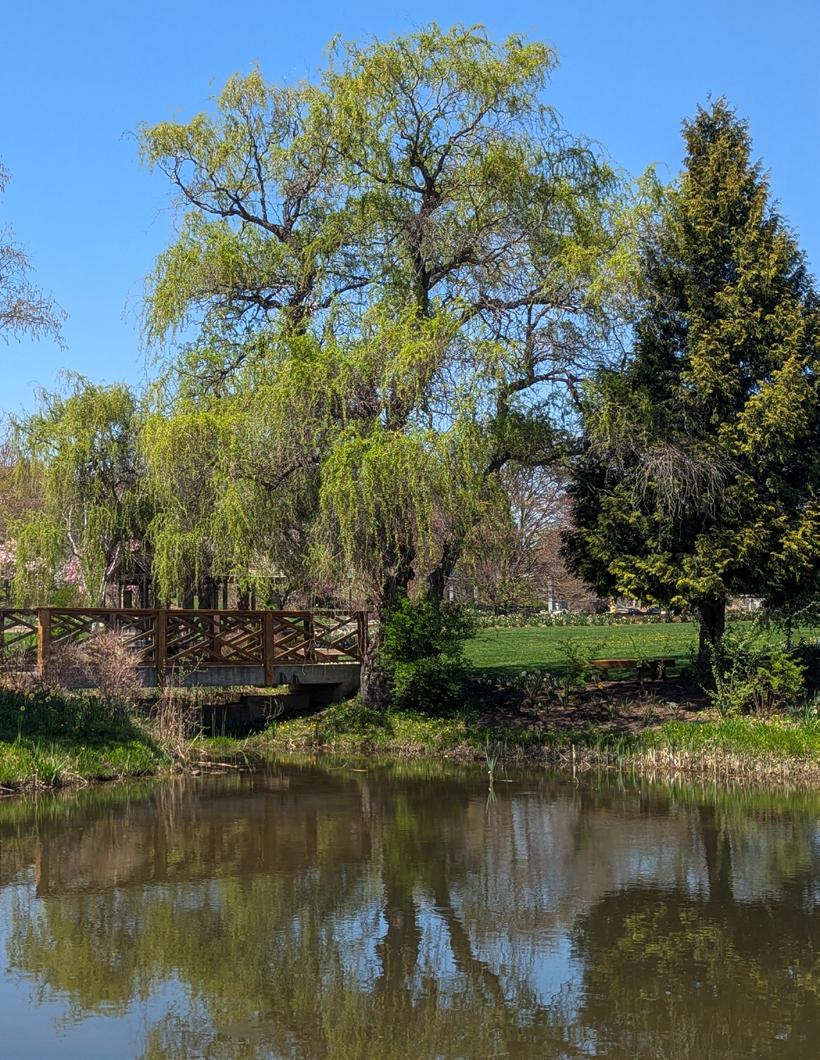
Informed by mentorship, industry partnerships, and interdisciplinary exploration, [capstone] projects are a blueprint for what the World Economic Forum has repeatedly identified as “the skills of tomorrow.”

Preparing for Tomorrow, Today: A Ground-Level View of Humber Polytechnic’s Capstone Culture
Bridging the Generational Divide: Soft Skills and Value Perceptions of Gen Z in
JIPE Authors’ Testimonials
Future-Focused Furniture: Students Showcase Eco-Friendly Chairs at Annual Design Competition
From Page to Stage: Emerging Writers step into the Spotlight
43 The Shape of Innovation 45 Unlocking Learning: Inside “Escape Humber” – Where Emerging Tech Meets Collaborative Play 51 “Connections – From Class to Career”: A Video Podcast Bridging Diverse Disciplines
From the Desk of the Longo Faculty of Business
Develop Your Spark
Quips and Quotes

May 2025
On the front cover:
First-place winners: STAX space-saving stacking side chairs designed by Philip Moriana, Max Labutte and Carter Rana. Image provided by respective students.
On the back cover:
Anju Kakkar, Humber Press’ Managing Editor, interviews Philip Moriana, Max Labutte and Carter Rana. Photo by Jeryl Daileg.
SPARK is published by Humber Press, housed in the Office of the Senior Vice-President, Academic at Humber Polytechnic. The opinions and views expressed in SPARK are those solely of the interviewees and do not necessarily reflect the views of Humber Polytechnic.
Launched in 2021, SPARK is a two-time Canadian Online Publishing Awards (COPA)-winning publication.
Published by Humber Press, Office of the Senior Vice-President, Academic Humber Polytechnic 205 Humber College Blvd., Toronto, ON M9W 5L7 humberpress@humber.ca
Connect with us humberpress.c a jipe.ca linktr.ee/humber_press humberpress@humber.ca linkedin.com/showcase/humber-research/
Editorial Team
MANAGING EDITOR
Anju Kakkar
EDITOR
Saran Davaajargal
GRAPHIC TECHNOLOGIST
Andrea Chan
PROJECT COORDINATOR
Marlee Greig
Disclaimer
Humber Press strictly adheres to Humber Polytechnic’s Brand Guidelines. In instances of style conflicts, Humber Polytechnic’s guidelines will take precedence. On request, this document is available in alternate e-formats.
EDITOR’S NOTE
Welcome to Issue #13 of SPARK—our little-but-mighty magazine where academic and polytechnic stories take centre stage.
This issue lands on your screen with the unmistakable scent of fresh possibility. Summer may be just around the corner, but the energy at Humber Polytechnic is still very much in motion. While capstones have been submitted, posters rolled up, and clickers powered down in some programs, the season also brings a shift—a different pace—for others. Across our campuses, faculty and staff continue to teach, develop curriculum, refine assessments, and lay the groundwork for future innovation.
SPARK Issue #13 steps back to reflect and forward to imagine. We celebrate the completed capstone projects that challenged students to think boldly, collaborate deeply, and present ideas that matter. But we also spotlight what’s emerging; faculty-led innovations shaping how we teach, how we partner, and how we prepare learners for the complexity of tomorrow.
And while we take our academic rigour seriously, we also believe in the power of storytelling with soul. You’ll find voices here that are thoughtful, funny, and unafraid to ask, “What if?”; the kind of voices that remind us why we teach, why we learn, and why we occasionally need caffeine strong enough to rewire the Wi-Fi.
Here’s to students who make us hopeful, faculty who make us better, and futures that aren’t just built but imagined, lived, and loved into being.

Also, a very happy nod to celebrating the unofficial start of summer, when Canadians collectively remember what the sun feels like and suddenly rediscover a deep, primal love for patios, parks, and “maybe we should just work outside today.”
And don’t forget—Humber Showcase is just around the corner! Visit us at the Humber Press and Humber Literary Review booth (yes, we are friends!) during the 90-minute Exhibit Centre. We would love to share stories, sparkly ideas, and maybe a few laughs (because why not?). It’s a great chance to connect, collaborate, and say hello in 3D.
Want more? Catch up on past SPARK issues, or explore JIPE, Humber’s peer-reviewed academic journal, at linktr.ee/ humber_press
With warmth, light, and a dash of academic mischief,

Anju Kakkar Managing
Editor,
Humber Press
Office of the Senior Vice-President, Academic Humber Polytechnic
BY ANJU KAKKAR, SARAN DAVAAJARGAL AND MARLEE GREIG
Over the past weeks, members of the Humber Press editorial team have quietly moved across the campuses of Humber Polytechnic, attending student showcases and capstone presentations in disciplines as varied as design, research analysis and justice. Our goal was simple: to listen, observe, and collect stories directly from the students and faculty behind these culminating projects. What we found was far more than the sum of presentations or prototypes—we encountered a live, evolving ecosystem of applied learning that is deeply aligned with Humber’s values, the Building Brilliance vision, and the global skills agenda.


RESEARCH ANALYST FORUM
ACCESS TO JUSTICE


COGNITIVE BIASES BEHIND THE WHEEL
SOCIAL MEDIA USE AND ACADEMIC PERFORMANCE
RECIDIVISM IN MALE HALFWAY



Capstone projects at Humber Polytechnic do more than mark the end of a semester. They function as realworld rehearsals for the professional stage. Informed by mentorship, industry partnerships, and interdisciplinary exploration, these projects are a blueprint for what the World Economic Forum has repeatedly identified as “the skills of tomorrow”— critical thinking, creativity, problem-solving, collaboration, and digital fluency These aren’t theoretical assets, but practical capabilities defining careerreadiness in a rapidly shifting global economy.
As a polytechnic institution, Humber’s education model is uniquely positioned to deliver on this promise. It does so by embedding applied learning opportunities into the academic calendar in a way that reflects both employer demand and student potential. The capstone experience is one of this model’s most visible and high-impact expressions. Whether students are redesigning urban furniture using recycled materials, crafting policy recommendations for social justice reform, or developing user-centred digital products, these projects become a professional calling card and a catalyst for self-discovery.
According to McKinsey & Company, the global labour market is experiencing an urgent “capabilities chasm”—a gap between what education systems traditionally deliver and what employers critically need. Capstone projects, when done well, can help bridge that gap. They enable students to apply what they’ve learned, navigate ambiguity, receive iterative feedback, and understand stakeholder expectations.
…these projects become a professional calling card and a catalyst for self-discovery.
These projects also reflect Humber’s alignment with Sustainable Development Goal 17 (SDG 17): Partnerships for the Goals. From collaborations with companies like Plastic Flux to community-based initiatives addressing housing access or digital equity, the capstone structure allows students to engage with external partners in ways that amplify mutual value. In its Futures of Education report that UNESCO notes “ the ability to collaborate across sectors, cultures, and disciplines is a defining feature of 21st-century education.” Humber’s capstone events embody that ethos.
These reflections also sit comfortably within the three pillars of the Building Brilliance vision:
x Reimagining Learning: Capstones push learning beyond the classroom and into the real world, often incorporating live data, prototyping, and client-based deliverables.
x Deeper Partnerships: Faculty and students co-create with industry, government, and non-profit actors, producing outputs that matter outside the institution
x Driving Impact: Capstone outcomes are not hypothetical. They often inform decisions, inspire change, or become the basis of startup ventures and further academic inquiry.
The World Bank has argued that education systems must prioritize “learning for employability” and embed mechanisms that allow learners to demonstrate their capabilities through portfolios and projects. Humber’s projects’ models are precisely this kind of mechanism. It’s a response to a world that doesn’t just ask what you know but what you can do—and who you’ve collaborated with in the process.
Across the events we attended, we witnessed students navigating real production timelines, budgeting against limited resources, pitching ideas to industry judges, and adjusting midstream based on feedback. We saw faculty act as mentors, critics, and motivators. We saw humility, pride, and grit. In every room, we saw a shared belief in education as a tool for employment and agency.
The upcoming editorial features of this issue aim to showcase that belief in action. We are proud to share a series of stories reflecting Humber’s academic excellence, student resilience, and the readiness for graduates to enter Canada’s workforce and innovation economy.
We hope they resonate with you— not just as snapshots of student achievement but as living proof of what polytechnic education can do when designed with care, clarity, and purpose.


WRITTEN BY MARLEE GREIG
The Barrett Centre for Technology Innovation buzzed with activity as graduating students from Humber Polytechnic’s Information & Communication Technology programs prepared to present their final capstone projects to a packed audience of supporters, faculty and engaged industry representatives.
This year’s expo featured over 80 projects developed by graduates from multiple programs, including Cloud Computing, Artificial Intelligence with Machine Learning, Enterprise Software Development, and Information Technology Solutions.
The ICT Capstone Expo is more than a demonstration of final-year projects— it’s a testament to student dedication, faculty mentorship and the power of hands-on learning.
One team, Polytechnic Innovators, consisting of Information Technology Services students Marina Carvalho, Christian Crawford, Kanwar Danish, and Parmjit Kanth, worked on updating an existing app using React Native.

They worked with industry sponsor Zodiac Group to modernize the app Meerby. Meerby functions as a modern-day call button, allowing retail customers to press a beacon on their phone or in-store that alerts employees that they need assistance.
Kanwar Danish spoke candidly about the challenges of mastering new technology, especially under pressure.
“Even for the most advanced developer or engineer working in the field for 20
years, learning a new technology always has its learning curve. I know it can get you anxious or overwhelmed but never feel like that’s going to hold you back,” he said.
For many students, these projects marked a first foray into practical application. Christian Crawford reflected on his experience of updating the in-store notification tool.
“I had zero background in coding two years ago, so getting into this app and
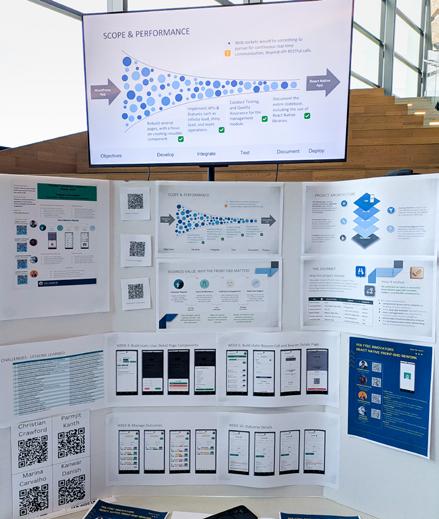
The project focused on object detection on sidewalks. Standard object detection models often miss small or partially hidden objects, limiting their effectiveness in real-world applications.
The team developed a modular, realtime perception system using three object detection models: RT-DETR, Mask R-CNN, and YOLOv11.
By working on the project, the team gained hands-on experience and skills necessary for AI, robotics, and autonomous systems careers, including model benchmarking, GPU/CPU optimization, dataset analysis, and system integration.
The idea for the showcase was spearheaded by Dr. Jonathan Kim, the Associate Dean of Information & Communications Technology within the Faculty of Applied Sciences & Technology from 2018 to 2023.
“[Students] need to understand how their knowledge and skills can be applied in the real world,” Kim said.
Ç Information Technology Services students Marina Carvalho, Christian Crawford, Kanwar Danish, and Parmjit Kanth’s poster presentation on their work on the app, Meerby. this project was big. It felt great to get into it because I had done nothing like this,” said Crawford. “It’s very cool. We’re really proud of it.”
Faculty of Applied Sciences & Technology professor Robert Morrone, who supervised multiple capstone teams, emphasized the value of realworld relevance.
“They get to actually work on projects that industry sponsors are going to implement or have already implemented. Some work on features that are on existing products, and they get to look at what life would be like working for an organization,” said Morrone.
Artificial Intelligence (AI) with Machine Learning students Lucas De Almeida Fernandes, Jaspreet Kaur, Chandana Raju, Mohammad Sayeed M. Syed, and Frederico Villar worked on a capstone project with industry sponsor Kevares.
“Capstone projects play a significant role in student success by allowing learners to apply the knowledge and skills they’ve gained throughout their academic journey in a real-world or practical setting,” said Timothy Wong, professor and capstone lead in the Artificial Intelligence (AI) with Machine Learning program.
“Through the capstone project, they can experience how that can be done in the real world because industry can give them feedback on how their project is going, and how their project can be applied in a real situation.”
Kim credits his staff and colleagues with making the idea a reality.
“I truly wanted to showcase what our students can do,” he said of the initiative, which began in 2019.
Since the inaugural ICT Capstone Expo, the scale of the event has steadily grown. In the first year, all the projects
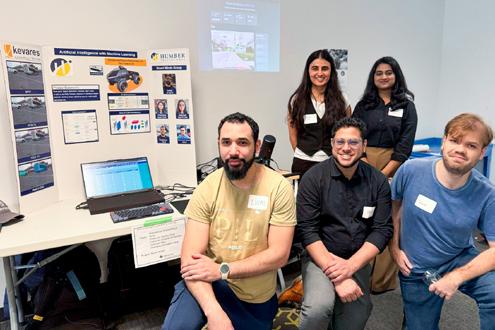

could fit on the first floor of the BCTI, but now the expo has expanded to the fifth floor.
As the semester comes to a close, the ICT Capstone Expo stands as a powerful testament to Humber’s dedication to applied learning, industry collaboration, and student empowerment. The event showcases innovative student projects that bridge the gap between theory and practice—offering a glimpse into a future shaped by talent, technology, and tenacity.
Faculty mentors like Morrone and Wong play a vital role in guiding students
“It’s
14 weeks of learning new technology and doing project management, on top of doing all of their other courses.”
—ROBERT
MORRONE, FACULTY, FACULTY OF APPLIED SCIENCES & TECHNOLOGY
through the challenges of their capstone journeys.
Wong encourages his students to pursue projects that spark their curiosity.
“Capstone projects can be both exciting and challenging,” he said. “We suggest students work on something of their interest, plan ahead, leverage and build on top of prior work, maintain communication with team members and sponsors.”
Morrone’s advice to students working on future capstone projects is urgent but straightforward.
“It’s 14 weeks of learning new technology and doing project management, on top of doing all of their other courses,” Morrone explains. “I tell them right at the beginning, ‘14 weeks go by pretty fast. You can’t waste a week.”
From creative concepts to real-world applications, the projects unveiled at the ICT Capstone Expo reflect not just academic achievement but the readiness of Humber students to step confidently into the careers they’ve worked so hard to prepare for.

WRITTEN BY SARAN DAVAAJARGAL
On April 14, 2025, the Humber Press team had the opportunity to attend the capstone presentations by the Bachelor of Paralegal Studies program students at the Humber Lakeshore campus. The classroom presentations were a showcase of the semester-long work students have been doing for their capstone projects and a demonstration of their commitment to making a difference in their community.
As a four-year honours degree program with accreditation by the Law Society of Ontario, the Paralegal Studies program prepares students for professional careers as licensed paralegals. In the last year of the program, the students enroll in the Access to Justice course for their capstone projects, as part of which they examine how lack of access to justice impacts vulnerable communities who seek legal protection. In this course, legal areas that have been covered in the paralegal studies
program are critically examined through the lens of access to justice.
Jasteena Dhillon, a law professor who teaches the course, notes that the capstone project experience exemplifies the holistic training students receive in the paralegal studies program.
After spending the first few weeks of the course reading and discussing the most updated academic research on access to justice, human rights, equity, diversity, inclusion and the law, the students have the opportunity to learn from licensed paralegals who come into the classroom to answer questions about a range of topics, from child protection and human rights to landlord and tenant advocacy. Building on this theoretical knowledge, students complete the course by selecting an access to justice issue they’d like to explore and demonstrating their knowledge through a thesis presentation and research paper for their capstone project.

This year’s capstone projects reflected the wide range of students’ interests, from examining victims’ rights to exploring the lack of access to justice in marginalized communities due to race and mental health issues. The students note that working on the capstone project has been an impactful professional experience.
Gurjot (Gigi) Singh examined the schoolto-prison pipeline for the capstone project. “I’m grateful to this course because it opened up my understanding and views about all of the discrepancies that kids and youth face,” says Singh.

Rachel Brown, who explored the lack of access to justice in marginalized communities, notes, “This experience reinforced my desire to work closely with marginalized and vulnerable groups in Ontario and Canada in general.”
For Dion Desserre, whose capstone project focused on victims’ rights, writing and research skills were the most important skills learned through the project. “This program has prepared us well for the industry because it has people from the field teaching us, taking theories, and applying them to real-life situations,” says Desserre.
“Paralegals are able to work with the everyday people about problems that are preventing them from living a life free of rights violations and justice barriers.”
— JASTEENA DHILLON, LAW PROFESSOR, LONGO FACULTY OF BUSINESS
A recipient of the 2023 Access to Justice Award from the University of Windsor Law School and Humber’s 2023 Distinguished Faculty Award, Jasteena Dhillon is an experienced lawyer with extensive international experience and industry expertise. Dhillon notes that the paralegal education at Humber has a special value for both practitioners and the community. “Paralegals are able to work with the everyday people about problems that are preventing them from living a life free of rights violations and justice barriers.”
In addition to her teaching responsibilities, Dhillon also serves as co-chief editor of the Journal of Paralegal Access to Justice. In partnership with Emond Publishing, the Journal is compiled by the Bachelor of Paralegal Studies program, which provides a forum to critically examine
issues related to the scope of paralegal practice and the role of paralegals in advancing access to justice.
Dhillon notes that the paralegal studies program prepares students for a wide range of career options, from opening up their own office as independent paralegals to serving in the government to working in corporate law firms. “I love it when students find their professional home,” says Dhillon.
Capstone projects are a demonstration of Humber Polytechnic’s commitment to building brilliance both inside and outside the classroom. The projects reflect the dedication of Humber faculty members passionate about training the next generation of paralegal professionals. For the students, the capstone projects mark an important milestone in their professional journey and pave the way for making a positive difference in Canada and beyond.
´ Professor Jasteena Dhillon and students in Access to Justice, Bachelor of Paralegal Studies, Humber Lakeshore Campus


LISTEN TO WHAT THE STUDENTS HAVE TO SAY ABOUT THEIR CAPSTONE EXPERIENCE:
Dion Desserre (00:12 to 01:28)
Rachel Brown (01:29 to 02:31)
Mackenzie Connolly (02:32 to 3:07)
Gurjot “Gigi” Singh (03:08 to 04:53)
Link: Capstone Projects: Access to Justice
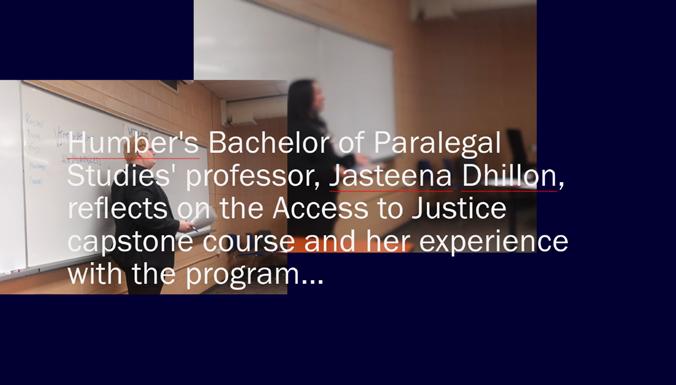
LISTEN TO PROFESSOR JASTEENA DHILLON DISCUSS THE PARALEGAL PROGRAM AND THE ACCESS TO JUSTICE COURSE:
About the program (00:11 to 03:31)
About the capstone/thesis course (03:32 to 04:44)
About industry partners (04:45 to 07:23)
On the future of the program (07:24 to 10:05)
On the most rewarding part of working with students in this program (10:06 to 12:44)
Link: Capstone Projects: Access to Justice with Jasteena Dhillon

WRITTEN BY MARLEE GREIG
Thesis is often described as a marathon and for fourth-year Bachelor of Social Sciences – Criminal Justice students, that metaphor couldn’t be more fitting. From narrowing down complex legal questions to navigating team dynamics and research ethics, students at Humber have spent the past year investigating into some of society’s most pressing challenges.
At a recent poster showcase held at the Lakeshore Campus, they presented their work with a mix of pride, exhaustion, and clarity about what it means to be a researcher in the field of justice.
“It’s like guiding them and coaching them through a marathon,” said Aqeel Saeid, program coordinator of the Bachelor of Social Sciences - Criminal Justice program. “It’s a very rewarding experience.”
According to Saeid, students face numerous challenges in the yearlong thesis process, including narrowing
down large research questions, getting enough participants and managing group dynamics.
“When it comes to writing a thesis, it’s not really a straight line,” said Saeid.
Guided by curiosity and personal experience, three groups shared their unique insights into their research as well as the thesis process overall.
Alyssa Michelle Ferreira and Chelsea Paglialunga’s research explored recidivism rates in halfway houses.
“I want to preface by saying that I work at a halfway house, which inspired me. We worked very hard in trying to figure out what exactly causes recidivism in male halfway houses in Canada,” said Ferreira.
Their hypothesis proposed that halfway houses in lower-crime neighbourhoods would be more successful in reducing recidivism compared to those in highercrime areas. Their findings supported this, highlighting key factors such as location, age, and length of stay as major contributors.
The team said the most significant challenge they encountered was a lack of existing research and data on the topic.

“It’s not until the actual end, where you have all the pieces of the puzzle, and you’re finally putting them together [that you think], ‘wow, all of this research wasn’t exactly for nothing,’” said Paglialunga.
Thesis advice? Don’t procrastinate!
“Start working on it as soon as possible, and don’t procrastinate. If you procrastinate and leave things for the last minute, sometimes it works out, but sometimes it doesn’t,” said Ferreira.
While some students examined systemic issues in the justice system, others focused on how digital behaviour intersects with academic outcomes. Using survey data from 47 undergraduate students, Chakshu Chakshu and Roshini Ravishankar investigated how social media habits influence academic performance.
“As a student, I’ve been using social media a lot lately, just to burn some time or [for] stress relief. I know it impacted me when I was studying,” she said.
Curious if other students were also impacted the same way, her team hypothesized that frequent social media use would negatively affect grades.

Ç Alyssa Michelle Ferreira and Chelsea Paglialunga with their poster presentation on The Internal/External Factors that Contribute to Recidivism in Male Halfway Houses.
On average, respondents reported 3.7 hours of daily use with session durations averaging 55 minutes. Instagram was the most used platform (95.7%), followed by TikTok (63.8%) and Snapchat (40.4%).
Their research found that entertainment use was the most frequent type of use— and most detrimental to GPA. However, students who used self-regulation tools and practiced time management tended to perform better academically.
Thesis advice: Pay attention in stats class.
“I would recommend that they pay as much attention [in stats] as they can because if they want to use the quantitative method for the thesis, that’s a must,” Chakshu said.

Not all projects focused on policy or personal habits — some explored how psychology plays out behind the wheel in real time.
Ariane Marak, Mahad Mohamed and Roy Walters examined distracted driving through the lens of cognitive biases—specifically the Dunning-Kruger
“As a student, I know I’ve been using social media a lot lately just to burn some time or for stress relief. I know it impacted me when I was studying.”
— CHAKSHU CHAKSHU, STUDENT
effect and cognitive dissonance—using Humber’s Driving Simulator Lab to collect data.
“We think texting while driving is something that really needs to be discussed, especially [since] a lot of college students, or youth in general, are driving, and you want them to practice safe driving,” said Ariane Marak.
Using the SIM lab, study participants did a five-minute driving simulation. The team sent participants text messages via WhatsApp and monitored how long (and how often) participants took their eyes off the road.
“[When] you just glance at your phone, just for a few seconds, you are going the length of a football field with your eyes closed. Anything can happen in five seconds,” said Marak.


She cites a National Highway Traffic Safety Administration claim that sending or reading a text takes drivers’ eyes off the road for 5 seconds. At 90 km/h, it’s the equivalent of driving the length of an entire football field.
Their research found that experienced drivers took their eyes off the road for 35 seconds, while novice drivers took their eyes off the road for 39 seconds.
“Find people that you work well with. That is very pertinent. I work very well with my partners. I’m very grateful to have been working with them. And go to a professor that you want to go to,” said Marek.
As these projects wrap up, Humber graduates leave with more than just grades—they gain critical research skills and insights that will guide their future careers and contributions to society.
…the thesis process isn’t linear — but it’s where many students find their professional voice for the first time
“Teen drivers acknowledge the dangers of texting and driving but still engage in it. They’re aware but justify it: ‘Oh, I’m texting at red lights. I’m texting at stop signs,” said Mahad Mohamed.
Mohamed is describing examples of cognitive dissonance, a cognitive bias wherein people know what they’re doing is wrong but attempt to justify their actions.
Thesis Advice? Pick teammates (and faculty advisors) that you trust
Across all three projects, students emphasized the importance of teamwork, time management, and mentorship. Whether they were navigating limited datasets, conducting simulations, or coordinating interviews, each team faced moments of doubt and discovery. Their advice to future students was consistent: start early, stay curious, and choose collaborators wisely. As faculty member Aqeel Saeid noted, the thesis process isn’t linear —
but it’s where many students find their professional voice for the first time.
The thesis showcase is more than an academic checkpoint — it’s a reflection of Humber Polytechnic’s commitment to experiential, student-centred education. As these students transition into careers in justice, law enforcement, research, and advocacy, they carry with them not just their findings but the applied skills and collaborative mindset that will shape their future impact.


WRITTEN BY SARAN DAVAAJARGAL
At Humber Polytechnic, research is a vital component of the Building Brilliance vision and one of the key drivers behind the pillars of reimagining learning, building deeper partnerships and driving impact. The Research Analyst graduate certificate program at Humber focuses on the theoretical, practical and ethical underpinnings of research while equipping students with the technical and professional skills necessary to do applied research in a variety of settings.
On March 28, 2025, the Research Analyst program hosted its research forum featuring speakers from industry partners and poster presentations from students in the program. Hosted at the Barrett Centre for Technology Innovation, it was a gathering that buzzed with the excitement of new insights, thoughtful dialogue and meaningful connections. Felicia Colasanto, Director of Research at BrandSpark International, shared her insights on how AI-moderated
research is being incorporated into survey methodologies, while Kevin Hare, Executive Vice President at Dig Insights, elaborated on the technological trends in research. The research forum offered an opportunity to network with industry partners while celebrating students’ work in the program.
Mary Takacs has been a professor and the program coordinator of the Research Analyst program since its beginning. Mary notes that the research analyst program’s advisory committee comprised of industry, corporate and community representatives helps ensure the curriculum always meets the industry demands. “The committee members review our curriculum, give us feedback on it, and we take their timely advice and modify the curriculum accordingly.”
The Research Analyst program recently launched a fully online asynchronous
program for domestic students across Canada to widen the program’s reach and impact. The program has been holistically designed to give students a competitive advantage in the current job market. “Because our program is housed in the Faculty of Liberal Arts & Sciences, we emphasize developing not only professional or technical skills but also critical thinking, communication skills, and values like respect for diversity and inclusivity. This gives our students a competitive edge because they’re bringing a wide range of skills to the workplace that make them global citizens who are also researchers,” says Takacs.
For students in the research analyst program, the curriculum helps them become career-ready citizens ready to meet the demands of the industry. Ankit Bahl, who is a second-semester student in the program, says, “The Research Analyst program is structured in a very holistic manner, touching bases on all


Student posters from Research Analyst Program.
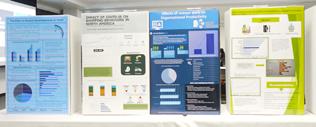

“I previously did a master’s degree in human genetics, and I used to dream of becoming a stem cells researcher. Now, the way I do research is changing, but I’m still in research.”
—PALGUN RAJ KOLLIPARA, STUDENT IN THE RESEARCH ANALYST PROGRAM
kinds of different methodologies, be it qualitative or quantitative. It provides us with hands-on experience that gets us ready to go into the industry.”
Vedant Trivedi, a student in the program, noted that enrolling in the program was a way to upgrade his skillset and make his employment profile more competitive. “I am in this program to upgrade my skillset and better meet the demands of the Canadian job market,” says Trivedi.
For Palgun Raj Kollipara, a student in the program, research is his life’s passion.
“I previously did a master’s degree in human genetics, and I used to dream of becoming a stem cells researcher. Now, the way I do research is changing, but I’m still in research. Research is trying to understand the nature of things, trying to understand the data and extrapolating what the data is saying.”
Carla Barrantes, a graduate of the Research Analyst program, recalls, “The program helped me gain more experience in SPSS, PowerBI, and Excel and sharpen my skills in qualitative research.” Asked about advice for new students enrolling in the program,
Barrantes says, “Always be curious, keep networking, keep learning, and don’t be afraid to share your ideas with others.”
The Research Analyst Forum exemplifies Humber Polytechnic’s commitment to helping students become careerready citizens in the workforce. From networking with industry partners to receiving hands-on experience through work placements, students gain the skills to transform their knowledge into meaningful work and tangible impact. At Humber, students build brilliance, sparking innovation and shaping the future.

Research and Innovation Corner shines the spotlight on research studies that have been published in the Journal of Innovation in Polytechnic Education (JIPE).
This issue features:
» Henrik Kraght and Lars Brøndum, long-time faculty members of KEA, Copenhagen School of Design and Technology, who published “Bridging the Generational Divide: Soft Skills and Value Perceptions of Gen Z in the Workforce” in JIPE Special Issue 2024.
» Humber Polytechnic’s recent graduates who have been published in JIPE General Issue 2024.
Read on to learn more about the research studies and the researchers behind them.
Read the full article published in JIPE: Bridging the Generational Divide: Soft Skills and Value Perceptions of Gen Z in the Workforce
FOLLOW-UP INTERVIEW BY SARAN DAVAAJARGAL
ABSTRACT: This research paper examines the growing disparity in value perceptions between Generation Z (Gen Z) and downstream companies that are set to integrate this new cohort of professionals. Gen Z, sometimes referred to as “Zoomers,” includes those born between the mid-1990s and early 2010s, predominantly the children of Generation X. Characterized by their digital fluency, entrepreneurial mindset, and desire for purpose-driven work, Gen Z presents both opportunities and challenges to traditional corporate structures. This study explores the underlying causes of the value perception gap between Gen Z and downstream companies, analyzing its impact on workplace productivity, collaboration, and employee retention.
Focusing on the technology and service sectors, which frequently recruit graduates from business and technology disciplines, this study employs a multi-method approach. It integrates quantitative surveys, qualitative interviews with downstream company representatives, and an indepth case study of a large corporation. These methods provide a thorough analysis of the generational dynamics shaping workplace interactions. Furthermore, the research draws on international insights to present targeted recommendations for three key stakeholders: Companies, Gen Z professionals, and Higher Education Institutions (HEIs).
The findings reveal significant misalignments in expectations around workplace flexibility, leadership opportunities, and career progression. While Gen Z’s adaptability and digital proficiency are assets, their expectations for rapid advancement and autonomy often clash with the structured, performance-focused

frameworks of many organizations. The study underscores the need for tailored talent management strategies, including flexible work arrangements, mentorship programs, and continuous learning opportunities that align with Gen Z’s unique needs.
By investigating collaboration among companies, Gen Z, and HEIs, this research provides a roadmap for creating a more inclusive, adaptive workplace culture. It emphasizes the importance of addressing generational differences to enhance productivity, retain talent, and ensure a smoother integration of Gen Z into the evolving professional landscape.
In this interview, Henrik Kraght and Lars Brøndum, long-time faculty members of KEA, Copenhagen School of Design and Technology, discuss what inspired them to pursue their research topic, why they chose the Journal of Innovation in Polytechnic Education (JIPE), and what innovation means to them. Watch the full video to hear their insights!

Henrik Kraght
Associate Professor at KEA, Copenhagen School of Design and Technology, with over 25 years of international experience in business leadership at director and executive levels. He has a strong background in digital transformation, strategic growth, and business development, having led high-performing teams across IT consulting, education, and professional services.
Passionate about organizational and talent development, Henrik specializes in leadership, innovation, and capability building, helping businesses unlock new opportunities and drive sustainable success. His expertise extends to digital strategy, automation, and process optimization, enabling organizations to navigate complex transformations and remain competitive in an evolving market.
With a track record of delivering impactful results, Henrik is dedicated to shaping the next generation of professionals through research-based education and industry collaboration. His approach integrates academic rigour with real-world business insights, bridging the gap between theory and practice to create meaningful learning experiences.
linkedin.com/in/henrikkraght

Associate Professor at KEA, Copenhagen School of Design and Technology, with over 25 years of international experience in the IT consulting and service industry at director and executive levels.
Renowned for consistently delivering results and developing high-performing teams, Lars has a strong background in strategic leadership, business development, and talent cultivation.
His expertise encompasses IT strategy, digital transformation, and process optimization, enabling organizations to navigate complex technological landscapes and achieve sustainable growth. Lars is passionate about guiding leaders, teams, and future professionals toward sustained success, leveraging his extensive industry experience to bridge the gap between academia and real-world business challenges.
Committed to fostering innovation and continuous improvement, Lars integrates academic rigour with practical insights, creating enriching learning experiences that prepare students to excel in a rapidly evolving digital environment.
linkedin.com/in/lbrondum

LISTEN TO WHAT HENRIK AND LARS HAVE TO SAY ABOUT THEIR RESEARCH JOURNEY:
On the inspiration and goals of their research study (00:00-01:51)
On why they chose JIPE and the importance of knowledge dissemination (01:52-02:34)
On what innovation means to them (02:35-03:07)
Link: Researcher’s Corner with Henrik Kraght and Lars Brøndum
The following are interviews with Humber Polytechnic’s recent graduates who have been published in the Journal of Innovation in Polytechnic Education (JIPE). Here is what they had to say about their experience getting published in JIPE—
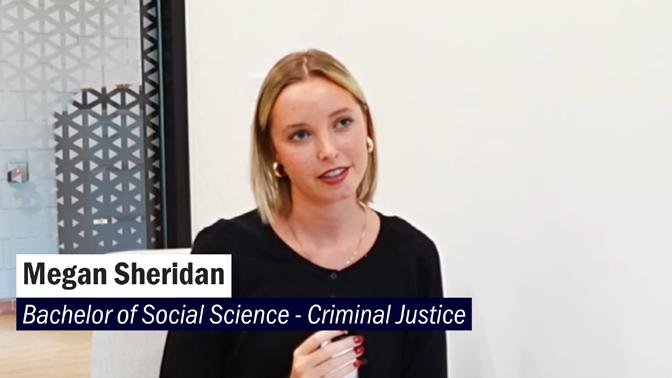
WATCH NOW
Article title: Examining Confidence Accuracy, Observation Skills, and the Dunning
Kruger Effect: A Simulation Study on Eyewitness Memory
Article authors: Megan Sheridan, Bailey Howard, Richelle Pang
Interviewee: Megan Sheridan
Link: JIPE Authors’ Testimonials: Megan Sheridan


Article title: Examining Confidence Accuracy, Observation Skills, and the Dunning
Kruger Effect: A Simulation Study on Eyewitness Memory
Article authors: Megan Sheridan, Bailey Howard, Richelle Pang
Interviewee: Richelle Pang
Link: JIPE Authors’ Testimonials: Richelle Pang
The Journal of Innovation in Polytechnic Education (JIPE) is an online, open-access journal for peer-reviewed and non-peer-reviewed papers that mobilize knowledge and insights generated by the global polytechnic community. We publish original research papers, review articles, brief reports, book reviews, and presentation summaries and our “micro-dissemination” options include innovation spotlights and essays.
JIPE welcomes submissions from all researchers and innovators, including but not limited to experienced researchers, scholars, everyday innovators, staff members, research assistants and students.

Read our Submission Toolkit to learn more.
Read the latest articles today. jipe.ca
WHY SHOULD YOU READ THIS?
Industrial Design students envision ‘a more sustainable future’ at 22nd Chair Show.
BY MARLEE GREIG




The Bachelor of Industrial Design program hosted its 22nd Chair Show in March showcasing second-year students creativity, technical skills, and dedication. The annual public exhibition and design competition celebrates students’ innovative designs and hard work.
Faculty lead Odin Cappello emphasized the multifaceted learning experience the Chair Show provides. Students not only demonstrate their technical expertise in sketching, CAD modelling, and prototype creation but also develop essential soft skills.
“They have to learn project management. They have to build relationships with suppliers. They have to solve problems they haven’t anticipated,” said Cappello.
ZAETA co-designer Matt Aubie said the show provided the team with an invaluable learning experience.
“We’re more comfortable with manufacturing, outsourcing materials, focusing on sustainability and focusing on things that we want to show the world and bring into the world,” he said.
They have to learn project management. They have to build relationships with suppliers. They have to solve problems that they haven’t anticipated.
—ODIN CAPPELLO, FACULTY, FACULTY OF MEDIA, CREATIVE ARTS, AND DESIGN
For many students, the Chair Show represents the culmination of 12 weeks of hard work. Despite the challenges, Cappello reassures students that perseverance always leads to success.
“I tell the students, it’s going to feel like a lot of work, and it is, but we always finish. Everyone always finishes,” he said.
GEO team member Peter Beerda said that despite obstacles and self-doubt, the payoff of the Chair Show is worth it.
“It’s so cool to see people enjoying something that we created and put months and months of work into,” he said.
This year’s Chair Show featured seven designs inspired by future-thinking, sustainability and small-space living. Each chair was required to incorporate Plastic Flux—a recycled plastic material—and feature a frame made of bent steel tubing.
Judges are local design professionals. They consider how ergonomic the chairs are, as well as how innovative and commercially feasible the concepts are.
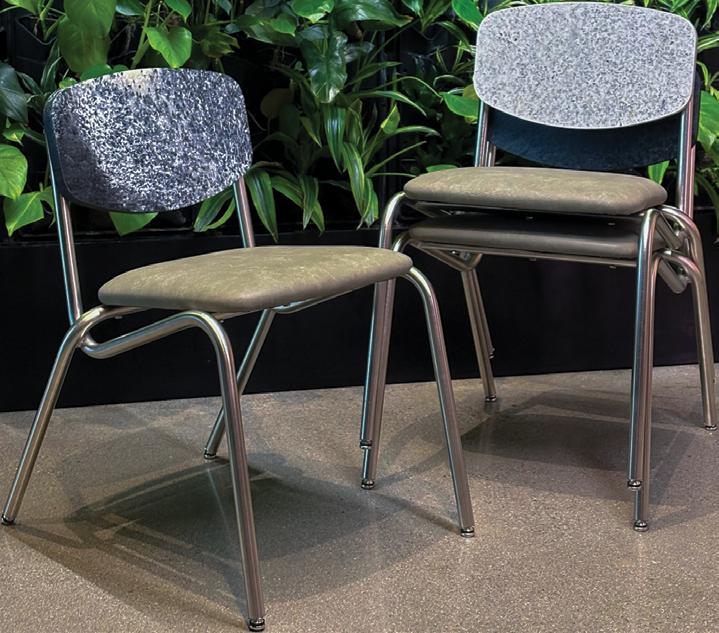

First-place winners STAX created space-saving stacking side chairs inspired by brutalist architect Paul Rudolph and fashion designer Rick Ownes.
“Our entire color palette, every fabric choice, even down to the finish on the steel, was all derived from brutalism and brutalist design,” said co-designer Philip Moriana. “We wanted to do something different, so that would catch everybody else a little bit off guard.”
WATCH NOW

LISTEN TO WHAT THE STUDENTS HAVE TO SAY ABOUT THEIR EXPERIENCE:
Link: Future-focused furniture: Bachelor of Industrial Design Chair Show 2025


Second-place winner LITERARY’s chair has an integrated wraparound table/bookshelf for avid readers.
“I live in a small apartment. [Co-designer] Vik lives in a small apartment. And of course, if you want to sit down and read for a long period of time, you need a side table book, bookshelf, etc.,” said co-designer Paige Farrow.
Third-place winners:

Third-place winner ZAETA tackled apartment living with a chair featuring a removable seatback double as a table.
“We wanted something that actually makes sense in people’s lives,” said Laur Conover. “Something that’s comfortable, something that’s easy to assemble and packable, and also something that lives with you for a lifetime.”
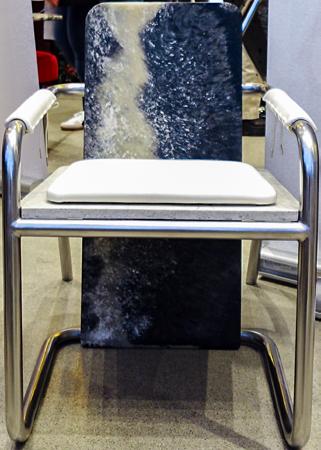
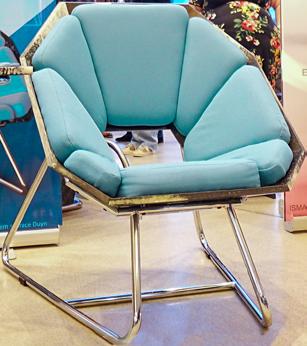
Named after the Greek word “arachne” meaning spider, ARANEA features an eight-legged design and bright red seat.
“The chair itself can grab attention just because of the flow and the colour, it grabs your eyes,” said co-designer Jagjeet Singh.

The People’s Choice Award winner, BLOOM, designed a lounger for creative spaces.
“It’s a very sculptural chair, so it brings ideas to you,” said co-designer Jaimee Branson. “It has a high back, so it makes you feel encompassed in fabric and material, so you feel safe and comfortable.”

Designed with continuous steel tubing and a floating wraparound shelf, GEO aimed for seamlessness.
“We wanted one seamless design,” said team member Ajrun Kabir. This meant creating a custom clip to hold the seat together without visible screws on the back.
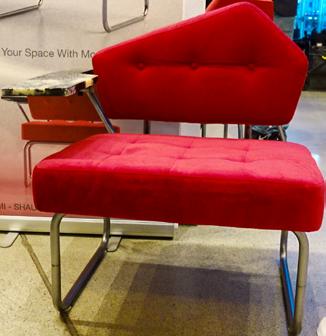
This year’s design concept had students envision “a more sustainable future,” with industry partner Plastic Flux providing recycled polypropylene sheets for students to incorporate into their designs. Plastic Flux collected 1,214 pounds of plastic waste in 2024 that would otherwise have ended up in landfills.
“All this plastic would have ended up in landfill, and it was garbage. To be able to see it being utilized like this is beautiful,” said Saksham Sharma, Creative Director at Plastic Flux and alumnus of Humber’s Bachelor of Industrial Design program.
The recyclable plastic material and steel frames make all the chairs 90 percent recyclable.
BLOOM co-designer Shraddha Ambati expressed satisfaction with this ecofriendly approach: “We’re thrilled that it’s a recyclable material. It makes us feel much better about this chair; if we ever want to get rid of it, we can always just recycle it.”
NOVELLE’s asymmetrical pentagonal seatback is a combination of team members’ visions.
“We wanted something that was bold, obviously, would stand out in a room and had personality, and that’s where the backrest came from,” said Ismael Elmi.
They really supported me. I’d always been interested in all forms of design, and I think that’s what Humber exposed me to. It was very multidisciplinary for me. I picked up so many different skill sets outside of just the core Industrial design skills.
—SAKSHAM SHARMA, HUMBER POLYTECHNIC ALUMNI
Industry partners for the Chair Show include Borgo Contract Seating who provided feedback and mentorship for students and access to their upholstery tools. Manortool Ltd., a supporting industry partner, bent the steel tubing parts for the students. Donors include Nienkamper, Copernicus Educational Products, Handling Space, and Anony.
Returning alumni Saksham Sharma described working with students as a full circle moment. He fondly recalls his time at Humber and the influence the program and his professors’ influence on his career.
“They really supported me. I’d always been interested in all forms of design, and I think that’s what Humber exposed
me to. It was very multidisciplinary for me. I picked up so many different skill sets outside of just the core Industrial design skills,” he said.
Having participated in the Chair Show himself, he wanted to pay forward the support and mentorship he received.
“I told this cohort, and the previous cohort, that they should not treat school like school, you know, like we say we’re a student of life—and it’s a cliche sort of statement—but I really wanted them to think and behave like professionals,” he said.
“They’re incredible designers; the program and the professors are setting them for success.”
WHY SHOULD YOU READ THIS?
Celebrate the connection between writers and readers at Humber’s School for Writers showcase.

FROM PAGE TO STAGE:
BY MARLEE GREIG
ILLUSTRATION BY FREEPIK
In a celebration of emerging literary talent, students from Humber’s School for Writers recently gathered in the Recital Hall at the Lakeshore campus to share their work and build community.
Alissa York, program coordinator of the Creative Writing Graduate Certificate program, said that the event, and public readings in general, highlight the connection between writers and readers.
“It’s just a visceral experience of the relationship with readers,” said York.
“You’re up there, you’re the writer, and your readers are right there. You’re sharing that connection.”
“I find that timing myself and forcing myself to face the proverbial blank page is the only way to really combat writer’s block.”
—MUSIE SEMERE, BCPW STUDENT

Each student had three minutes to present readings drawn from their own creative projects, offering a compelling glimpse into the depth, diversity, and emotional resonance of voices coming out of Humber’s Creative Writing Graduate Certificate (CWGC) and Bachelor of Creative and Professional Writing (BCPW) programs.
York hopes the audience leaves impressed with the freshness of the writing and the diversity of voices, subject matter, and form that students’ works represent.
The evening reflected the wide range of styles and subject matter cultivated at Humber—from mythological retellings to science fiction revenge fantasies to deeply personal narratives of identity and home.
Caroline Tuccinardi, a BCPW student, read an excerpt from her poem ‘To Watch a Star Fall,’ inspired by the myth of Icarus but set in a modern context.
“I was wondering who [Icarus’] mother was in the story because we all hear about his father, right? And then after I researched it, I couldn’t find anything about a potential mom, so I kind of just made one up myself,” she said, noting that she had always been interested in mythology and space.
Elfreda Tetteh, a Creative Writing graduate and co-host of the event, read from her sci-fi manuscript.
“I’ve travelled a lot, lived in several places over the years, and I used to write only about home. And I think after I
travelled so much, I realized that I didn’t remember what home was anymore. So, I started to write sci-fi and fantasy because then I could make my own,” said Tetteh.
A lifelong fan of the genre, Tetteh cited influences from children’s author Enid Blyton to Hugo Award-winner Roger Zelazny.
Chyx Xyng read an excerpt from their manuscript, The Letter A, which the author described as ‘genre nonconforming novel about gender dysphoria.’
Xyng, a Creative Writing Graduate Certificate graduate, said that after years of writing financial documents, they branched out into creative writing.
“I’ve always been a writer of brutally boring stuff. About two years ago, I decided to write something that would also make people cry, but more of an emotional cry, as opposed to tears of boredom,” they said.
Elfreda Tetteh said that she pursued creative writing after years of working in copywriting.
“Someone once told me that it’s like the spirit of writing is chasing me. I have tried to do so many things. I try to fall in love with so many things.” Tetteh said. “I just keep coming back to it. And honestly, I think I’m just really tired of running.”
Looking to beat writer’s block?
“Read, read, read widely, read voraciously, read like a writer, read like a reader and write a lot, and make room, time and space for your writing and take it seriously,” said York.
Elle Warr-Addae, a BCPW student, describes her writing process as frantic and hectic, involving the use of notebooks, paper, and a room filled with maps, strings, and post-it notes.
“Anytime I get an idea, I just slam it on the wall, and then I synthesize it and bring it together,” she said. Warr-Addae read two poems, “King Conquer,” inspired by an unreleased song she wrote 10 years ago, while the other, “Mathematics,” is about the subject itself.
For others, consistency is the key to a good writing practice.
“I find that timing myself and forcing myself to face the proverbial blank page
“I’ve travelled a lot, lived in several places over the years, and I used to write only about home. And I think after I travelled so much, I realized that I didn’t remember what home was anymore. So, I started to write sci-fi and fantasy because then I could make my own.”
—ELFREDA TETTEH, CWGC STUDENT
is the only way to combat writer’s block,” said Musie Semere, a BCPW student.
“If I can get something on the page, even if I’m not ultimately going to use it later, I consider it a success.”
Semere said the program helped him explore writing styles and develop his own unique voice and sharpen his writing skill set.
During his time in the program, he has served as a poetry and fiction editor for Arrival, an online art and literary magazine. Arrival, led by Bachelor of Creative and Professional Writing students, showcases the work of students enrolled in post-secondary creative writing programs.
Students credit the Humber School for Writers with providing support while they hone their craft.
“[The program] made me much more confident in who I am and the fact that I can write,” said Tuccinardi, who placed third in the 2023 High School Flash Fiction Contest. The contest, run by the Bachelor of Creative and Professional Writing program, accepts short fiction
from secondary school students from across Ontario.
Warr-Addae admits that, despite writing a lot, she used to be uncomfortable sharing her work. However, the program’s workshop environment means that students share their work, read to each other and provide each other feedback.
“I just like sharing my work now, and that was the biggest hurdle I had to overcome,” she said.
According to York, finding other writers to build community with is the best way to develop your voice.
“Writers understand writers better than anybody else,” she said.
The Lit Celebration showcased the power of storytelling as a means of self-expression, transformation, and finding belonging. Across genres and forms, the emerging writers shared work reflecting both personal journeys and a shared commitment to creative exploration.
BY ANJU KAKKAR
Innovation is one of those words we use often, and rightly so—it holds a magnetic charge. It points to what’s new, what’s possible, what could change everything. But in our collective race toward disruption, I often find myself wondering: What shape does innovation really take in a polytechnic context?
At Humber Polytechnic, innovation is not just about what’s next—it’s about how we teach, how we learn, and how we build futures that are both agile and grounded. It is less of a spark that explodes and more of a current that moves through our halls, shaping the way we prepare learners for the complexity of tomorrow’s world.
As a proud member of Polytechnics Canada, Humber is part of a national conversation about what post-secondary institutions must become in order to drive real productivity and prosperity. Their recent framing resonates deeply:
“Applied research, work-integrated learning, and industry-aligned programs are not just educational tools—they are Canada’s engines of innovation.”
And that’s precisely what we see in the two editorial features that follow in this issue of SPARK—our COPA-awardwinning magazine that now lives within the Academic Division’s storytelling and knowledge-sharing hub. These two stories come from Humber’s Priority 3 Academic Plan projects, and each one embodies the kind of innovation that deserves to be seen, felt, and celebrated.
The first, Escape Humber, is a powerful metaphor in itself—an immersive learning experience using escape room methodology to teach teams how to navigate emerging technologies. It is playful, deeply interdisciplinary, and full of moments where students must apply critical thinking, communication, and resilience under pressure. This is innovation grounded in the pillar of Reimagining Learning—an act of creative courage by faculty who saw the need for new modes of engagement and met it with imagination and technical savvy.
The second story, Connections – From Class to Career, reflects innovation not through devices or simulations but through conversation. This podcast brings faculty together across disciplines to explore shared values— like professionalism, ethics, and critical thinking. It is about naming the invisible threads that connect what we teach in
They model what is possible when we see each other not only as colleagues but as co-creators of something larger than ourselves.
our classrooms to what students will need in the world. In doing so, it speaks directly to the Driving Impact pillar, where knowledge translation meets relationship-building and institutional wisdom is shared with generosity.
Both projects also contribute to the pillar of Deeper Partnerships —not just with external industry or community, but internally, across program silos and disciplinary divides. They model what is possible when we see each other not only as colleagues but as co-creators of something larger than ourselves.
At Humber Press, we’re privileged to document and amplify these efforts. Now nestled within the Academic Division, we publish SPARK and the
Journal of Innovation in Polytechnic Education (JIPE) as part of our mandate to champion scholarship, creativity, and applied learning in ways that resonate beyond the page.
And so, as you read the articles that follow, I invite you to imagine alongside us:
x What else could innovation look like if we defined it by how it makes people feel—engaged, empowered, capable?
x What stories are waiting to be told in your own classrooms, labs, or virtual spaces?
Let’s keep shaping the current— together.
WHY SHOULD YOU READ THIS?
Explore how Humber faculty members are using an escape room for educational purposes and reimagining learning inside and outside the classroom.
BY ANJU KAKKAR AND SARAN DAVAAJARGAL

PROJECT NAME : Using an Educational Escape Room to Teach Multidisciplinary Teams About Emerging Technology
At Humber Polytechnic, innovation often arrives not with fanfare but through curiosity, collaboration, and experimentation. That spirit pulses at the heart of Escape Humber, a Priority 3 project that transforms education into something immersive, playful, and deeply human.
Led by faculty from Multimedia Design & Development, Theatre Production and Web Development programs, the project uses an educational escape room format— powered by Extended Reality (XR), Artificial Intelligence (AI), Internet of Things (IoT) and gamified design—to foster cross-disciplinary learning, teamwork, and real-world problem-solving.
This isn’t just a classroom innovation—it’s a hands-on, hearts-in approach to learning that prepares students to be agile, creative, and ready for the complexities of the future.
Tanya Greve, program coordinator, Theatre Production; Sean Doyle, program coordinator, Web Development; and Robert Blain, program coordinator, Multimedia Design & Development standing inside the Nebula Dawn, the escape room they built with their students.
The following is an excerpt from our full video interview with Sean Doyle, program coordinator and professor of the Web Development program; Tanya Greve, program coordinator and professor of the Theatre Production program; and Robert Blain, program coordinator and professor of the Multimedia Design & Development program at Humber. To explore the entire conversation, watch the video linked at the end of this article.
“If you look at some of the academic research, there is a small body of work that speaks to this. They found that doing the escape room or the gamification of learning has been an effective process.”
—ROB BLAIN, PROGRAM COORDINATOR AND PROFESSOR OF THE MULTIMEDIA DESIGN & DEVELOPMENT PROGRAM AT HUMBER
We sat down with the project’s faculty leads to decode the thinking behind the puzzles, the power of interdisciplinary collaboration, and the role of play in reimagining teaching and learning.
HP: What inspired you to pursue the idea of escape rooms as “living classrooms”?
ROBERT BLAIN : As we are in academia, we have courses and students who are coming through every year. And what we wanted to try and do was bridge that gap in the classroom—so when you go into the escape room, you can play a puzzle. But there are also learning materials for how to build that puzzle. And as we keep growing it, people could then design and make their own puzzles.
TANYA GREVE: With my students in theatre production, they just want to get their hands dirty and build things. At one point where I was trying to figure out what things the students should build because we usually do shows and installations. Sean and I had a conversation pre-pandemic where we were like, “Escape rooms? Should we build one?” My faculty got totally excited. And then, it became

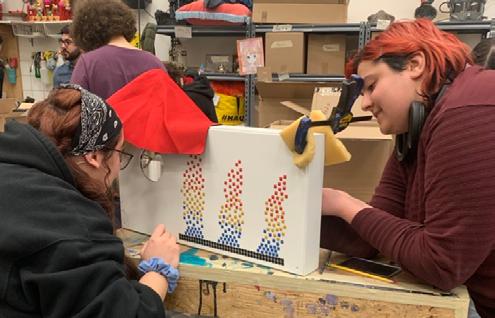
Ç Top: The “Life Support System” switches puzzle in an early prototype stage, created with the tinkercad.com online application.
Bottom: Work-in-progress pictures of the escape room.
a larger conversation about, “How do we integrate it into the rest of the curriculum properly?” But a lot of the time, especially with shows, you build something, you do the show, the show ends, and it gets tossed in a dumpster. So this was a marvellous way of taking something the students built and having some level of longevity to it, as well as being able to see the interconnectivity of stuff that they don’t know in something that’s built with wood, paint, and props.
SEAN DOYLE: For the theatre folks, the puzzle of building a set where the audience has to be in the set—it has to be an audience-proof set—was an interesting challenge.
HP: What makes escape rooms uniquely effective for improving learner outcomes?
RB: If you look at some of the academic research, there is a small body of work that speaks to this. They found that doing the escape room or the gamification of learning has been

Ç Work-in-progress pictures of the escape room.
“It’s ballooned a bit beyond even what we were imagining when we were just imagining this project to begin with.”
—TANYA GREVE, PROGRAM COORDINATOR AND PROFESSOR OF THE THEATRE PRODUCTION PROGRAM
an effective process. They surveyed students, and they found that students enjoy this method. One of the big things that they have flagged, though, is that the time to actually build an escape room as part of your normal classroom is often difficult. With this project, specifically, we were able to go to Innovative Learning at Humber and
get some buy-in from them before we tried to commit too much time and effort because it’s a big undertaking.
SD: As Tanya mentioned earlier, this escape room has this perpetuity to it, where the challenge can be to either remodel it or start from scratch. We can pull out a puzzle and make that
a learning component for different courses or have students redesign that component. There’s the modular and ongoing nature of it. I think that makes it different from anything else I’ve seen.
TG: There is also tremendous buy-in from the students. There is not a day that goes by when there isn’t a student from some other program peeking in that room and going, “What is that? Is that an escape room? Cool!” It’s ballooned a bit beyond even what we were imagining when we were just imagining this project to begin with.
HP: Can you share examples of how different disciplines are involved in the design and development of the escape room?
TG: Every single person in my theatre production program has had their hands on the physical building of the escape room. We’ve integrated it into our Experiential Learning Course, so there are 70 students who have had their hands either in the physical building of the room itself or they’ve built props for it. They’ve built weird aliens and things that link to the actual space. Other students have built dummy panels that mirror the real puzzles and make the room a little more fulsome. Our lighting students have created the lighting for the room. They’ve learned how to do LED lighting within the context of the piece. Our sound students have created all the sounds you’ll hear in the experience. Our video students have created the immersive video. With that, there are around nine or ten faculty that are interconnected. For my program, there are about four courses that are directly connected, and then the whole student body of both first and second year are
fully involved in the creation of the piece. That’s why we’re pushing to get it done before they graduate.
SD: In the digital realm, what’s so exciting about working with the theatre folks is that they’ve been mastering interdisciplinary collaboration for literally millennia. [The partnership] was fun for us—discovering those gaps, discovering that language together, and building those bridges together. It’s been fun. We’re richer. I would say I’m richer as a faculty member for this collaboration.
RB: The biggest challenge was getting the room built. But once we finally get this built, the next thing is, for me specifically, to use this in my classes as assignments. If you want to remake, say, the intro video when we’re learning how to make videos, shooting and editing things. It is an example of where it could go. Some of the exciting next steps are future collaborations within the programs and clusters, as well as with some of the other clusters.
HP: How do emerging technologies enhance the educational aspect of the escape room?
RB: I still like learning—that’s one of the reasons why I’m here. With puzzles, sometimes we came up with many different ideas, and [we knew exactly how to do some of them]. There are others that we don’t know how to do, but I think that’s what we wanted to learn, and then hopefully pass on some of those materials to students and the Humber community at large. We also made our own assistant—we thought, “Well, what if we made our own Alexa and we call it the Oracle?” Essentially, it’s allowed us

to go and learn—when you start talking to a smart assistant in your house, what are all the different little things that are going on there and all the little pieces that need to be figured out? And it’s been a really interesting experience to go through that and make something that is still in development right now. It starts to touch on things like Artificial Intelligence and how it comes into the world. You begin to see how these things are done.
SD: What’s great about using Artificial Intelligence is that it can remove a lot of the technical barriers. You can have an idea, and you have this helper [called AI] that can help you with parts and pieces of it. My takeaway from this project has been that we can use it as a helper—not necessarily to do the work for you, but to get you started and get your idea to come to life.
HP: How do you see this project contributing to the three pillars of Humber’s Building Brilliance vision— driving impact, reimagining learning and deeper partnerships?
SD: I teach web development, and one of the puzzles I’m designing as a
learning module for my students covers something we don’t usually cover in the curriculum. In terms of impact, my hope is that it has them thinking beyond the screen of a webpage and thinking about, “How can I use my skills to interact with the world?” and not just for banking applications and things at social media sites, but to interact with the world with their existing skills and break out of the screen to explore and invent.
TG: My students are builders. They get their hands dirty. After graduation, they hang lights for concerts, live in construction shops and build physical things. I think the people who end up having longevity in the industry that I teach in are the ones who understand the connection of what they are building to a bigger picture. I think this project has been huge for the students. I’ve told them every single day that this project and what they are building are going to live far beyond them graduating from this program. We hope that the project will then travel to other campuses. They’re excited for other students and other programs to see their creative work and understand that there’s a connection
WATCH NOW
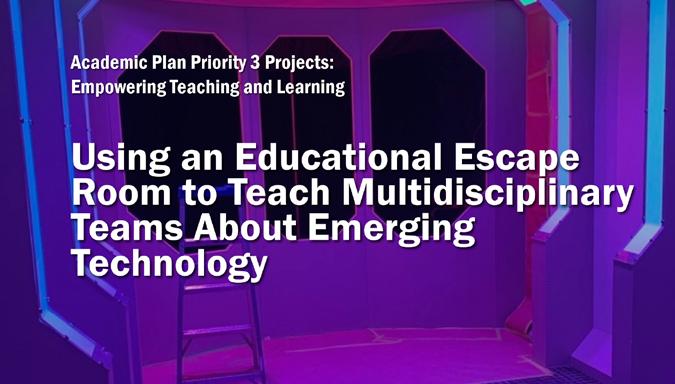
WATCH WHAT THE TEAM HAVE TO SAY ABOUT THEIR EXPERIENCE:
The Inspiration Behind the Escape Room (00:13 to 02:08)
Cross-Disciplinary Collaboration in Action (02:09 to 04:46)
On Artificial Intelligence (04:47 to 06:22)
On Accessibility and Inclusion (06:23 to 07:36)
Next Steps and Future Collaborations (07:37 to 10:!4)
Link: Unlocking Learning: Inside ‘Escape Humber’

“…discovering those gaps, discovering that language together and building those bridges together. It’s been fun. We’re richer […] for this collaboration.”
—SEAN DOYLE, PROGRAM COORDINATOR AND PROFESSOR OF THE WEB DEVELOPMENT PROGRAM
between what they build and other people’s experiences. I think it’s hugely important for my students to understand the interconnectivity between what they build and what people’s experiences are.
RB: The interconnectivity is a great thing for impact. We started to have conversations with campuses in other countries, “How could you contribute to this project, and how could you almost have a satellite location?” We’ve talked to people in Denmark, and it was like, “How could we have a live escape room experience going on between people in Denmark and Canada at the same time?” I think that’s another great project to chase after. With a project that’s so large and interconnected, you realize that you can’t do everything by yourself, and that can be a bit hard

because sometimes people want to control everything. With this project, there are so many variables, and you need to have trust in other people. Being able to rely on other people and building out your network are skills that are learned. With this project, you can start to see, “I can take those skills, and I can use them to build, say, a puzzle or things like that.” We did user testing with some students from our Bachelor of Design User Experience Program, and that was one of the things we had to prime them on when we were testing puzzles. It’s different than testing a website. It’s okay if people don’t solve the puzzle. We wanted to learn that, and sometimes the puzzles [will be] a bit harder, and that’s okay, too. I think those are some good things to uncover as well.
As our conversation wrapped, one thing became clear: Escape Humber isn’t just about learning to solve puzzles—it’s about building the mindset to work across differences, solve collaboratively, and trust the process of creative risk-taking. This is innovation in action—rooted in the values of polytechnic education and brought to life through intentional design. As Sean Doyle stated, the escape room gives students the opportunity to “interact with the world with their existing skills and break out of the screen to explore and invent.”
WHY SHOULD YOU READ THIS?
Learn about how a video podcast project led by Humber’s English professors are building connections, sparking insights and inspiring the next generation.
BY ANJU KAKKAR AND SARAN DAVAAJARGAL

PROJECT NAME : Connections – From Class to Career
What happens when Humber faculty sit around a podcast mic and conduct interviews with innovators, change-makers and trailblazers? The answer is a symphony of perspectives—and the foundation of Connections – From Class to Career, a podcast series featured as a Humber Polytechnic Academic Plan Priority 3 project. In doing so, the project offers a compelling example of how Humber faculty bring the Humber Learning Outcomes (HLOs) to life—making abstract skills like critical thinking, communication, and career readiness visible and tangible for students.
At first glance, this might look like just another podcast. But beneath the surface is a powerful rethinking of how we teach and why we teach. The series tackles big themes such as professionalism, ethics, and resilience and asks Humber faculty members, graduates, and community members to reflect on how these values show up in their courses, conversations and commitments to students. In doing so, the podcast helps students uncover the invisible threads between personal values, academic learning, and future careers.
Mark Andrade and Michael Spencer talk with Leanne Milech—Writer, Lawyer, and English Professor at Humber—about the importance of gratitude and kindness.
The following is an excerpt from our full video interview with Mark Andrade and Michael Spencer. To explore the entire conversation, watch the video linked at the end of this article.
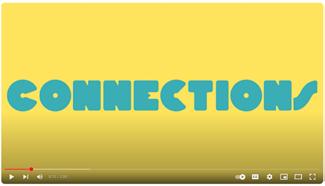
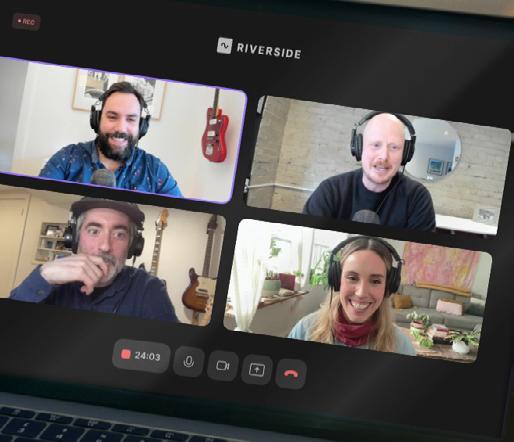
Ç Mark Andrade and Michael Spencer talk with James Reid and Jacq Andrade—two Humber film grads—about their experiences in the production industry.
“Through doing our research and presenting at conferences, we started noticing these core skills, such as resilience, curiosity and lifelong learning, come up again and again.”
—MARK ANDRADE, DEPARTMENT OF ENGLISH, PROFESSOR, FACULTY OF LIBERAL ARTS & SCIENCES
We met with Mark Andrade and Michael Spencer, faculty members in the English department, to find out what inspired them to start the project, how the podcast enhances learner outcomes, their plans for the project and more.
HP: How did the idea for the Connections podcast come about?
MARK ANDRADE: We’re currently in the stages of revamping our courses in the English department. Through that process, we started to think about our
courses and how the courses connect to other program areas. And then we started thinking about how students aren’t just learning from the classroom, but they’re bringing in their hobbies, their backgrounds or interests. So we started to think about how the podcast could be a way to show students not just the connectedness of their education but also how the workplace is also a part of that.
MICHAEL SPENCER: Mark and I would meet outside of the school and talk
about work and what we’re doing in the classroom, but then inevitably, we start talking about our own lives, and we realized that the things that we do on the side are connected to the things that we are teaching our students and what we’re talking about in class. So we started to see the connections between our lives and the things we’re doing in class and realized that that might also be true for students and other people, and we thought it would be useful to share those conversations in a way.
HP: What gap does this initiative address—for both students and faculty?
MS: The podcast allows us to take the learning outside of the classroom and show our students, through these conversations, that the things we’re talking about in class and the skills that we keep saying are important are important by talking to industry experts outside of the classroom and the school. It allows us to connect the dots and show students that there is a connection between what we’re talking about in class and outside of the class.
MA: Sometimes employability skills can be hard for students to see. With the video podcast, we were hoping that, literally, they could see their professors connecting with other professors, industry professionals and people who are doing great entrepreneurial work. And we wanted to highlight that what they learn in the classroom does have value outside and vice versa. The podcast is also just a current and popular format. So we use that as a way to show these connections between what students are learning and their hopeful future professional lives as well.
HP: How do you see this project contributing to the driving impact pillar of
WATCH NOW

‘Connections podcast – Universal Language’
Mark Andrade and Michael Spencer, faculty members in Humber Polytechnic’s English department, talk with Mohamed Hassan - Manager of Player Marketing for the CFL, Director of Somali Together, and Professor in the Sport Management Program at Humber - about the universal language of sports.
Link: Face the World Head On: Mohamed Hassan on Leadership, Identity, and Impact
WATCH NOW

“Connections podcast – Realizing your own strength”
Mark Andrade and Michael Spencer, faculty members in Humber Polytechnic’s English department, talk with Tori Baird, Founder and Owner of Paddle Like a Girl, about the power of realizing your own strength.
Link: Nature as a Teacher: Tori Baird on Confidence, Creativity, and Carving Your Own Path
Humber’s Building Brilliance vision?
MS: The podcast does a good job of showing diverse kinds of leadership and what that leadership might look like to students. And that leadership can look many different ways, sound like many different things and manifest itself in different ways. All the people we spoke to are leaders in their own ways. And I hope the podcast shows those different forms of leadership and how people can drive impact in their own ways, in their own communities and their industries.
MA: Through doing our research and presenting at conferences, we started noticing these core skills, such as resilience, curiosity and lifelong learning, come up again and again, whether it is from the World Economic Forum, Humber Polytechnic or industries. Our podcast touches on those thematic core skills.
HP: Were there any moments on the podcast episodes that particularly moved or stayed with you?
MS: The episodes all had their moments. For me, it was the conversation with Mohamed Hassan. He leads the player marketing for the Canadian Football League (CFL), and I have a personal interest in the CFL. So, it was an interesting conversation to begin with. But he also talked a lot about the role of his parents as Somali immigrants coming to Toronto, and how the risks that they took as immigrants and as part of the diaspora community here have influenced his own attitudes, motivation and drive, and how that all connects to the work he does as a marketer, but also with his work to uplift the Somali community and bring them together through sport. That episode stayed with me.
MA: We loved each episode, and each guest brought a unique perspective. In particular, through our conversation
with Matt Maw, who’s an Indigenous label director for Red Music Rising, it was interesting to hear him reflect on his journey through the indie Toronto music scene and how he, at times, kept his Indigenous identity separate. At a certain point, he saw them coming together and became an advocate for Indigenous music and promoting it. It was him reflecting personally on his experiences and journey, talking about his family and how it intersected with an opportunity to be the director of an Indigenous-owned and operated label. I think it’s powerful for students to see how your personal life can sometimes inform the direction you take in your professional life.
HP: What is the current status of the project, and how do you see it evolving in the future?
MS: We are currently wrapping up all the episodes, and we are working with our wonderful student editor, Sam, who is working on polishing the episodes. We are creating a lot of learning outcomes that put season one to rest. We are in the headspace of finishing season one, but we have had some conversations, and even when we were drafting the proposal, we realized that this is a great podcast that could continue to season two. We’re not podcasters by trade, and we’ve learned a lot from season one. We could improve on certain things and focus on different aspects. But I think moving forward, we thought either we could be hosts for season two, or there could be an opportunity for other faculty at Humber to take or have more student involvement. It’d be powerful to get more students involved, get their perspectives and voices, and even have them be guest hosts.
MA: I think centring student voices more would be great. What exactly does that look like? I’m not sure, but
“Through doing our research and presenting at conferences, we started noticing these core skills, such as resilience, curiosity and lifelong learning, come up again and again.”
—MARK ANDRADE, DEPARTMENT OF ENGLISH PROFESSOR, FACULTY OF LIBERAL ARTS & SCIENCES
having students ask those questions and finding the people to ask those questions would be interesting.
At Humber, driving impact means making space—for diverse voices, personal journeys, and values that echo far beyond the classroom.
In a world saturated with noise, Connections – From Class to Career reminds us that deep learning begins with listening. Through thoughtful dialogue and cross-disciplinary respect, this podcast series embodies the kind of academic storytelling that not only informs but transforms.
“Connections – From Class to Career ” is more than a podcast—it’s a campuswide conversation that prepares students for a future they are already shaping.

WATCH THE WHAT THE TEAM HAVE TO SAY ABOUT THEIR EXPERIENCE:
The Origins of “Connections – From Class to Career” (00:15 to 01:27)
The Research and Desire for Long Form Conversations (01:28 to 02:15)
Interconnectedness and Learning Beyond the Classroom (02:16 to 05:00)
Institutional Learning Outcomes (05:01 to 05:54)
Inspirational Interviews (05:55 to 08:19)
Future Evolution of the Podcast (08:20 to 09:11)
The Accessibility of Digital Podcasts (09:12 to 10:12)
Final Thoughts (10:13 to 11:20)
Link: Connections: From Class to Career
WHY YOU SHOULD READ THIS:
Explore stories of leadership and innovation from across Humber Polytechnic!

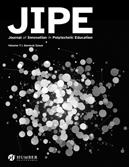

The future belongs to a different kind of person with a different kind of mind: artists, inventors, storytellers-creative and holistic ‘right-brain’ thinkers.

—Daniel Pink, author







FoUrTh-yEaR sTuDeNtS aNd fAcUlTy iN tHe BaChElOr oF CoMmErCe – DiGiTaL BuSiNeSs MaNaGeMeNt pRoGrAm cElEbRaTeD tHe sUcCeSsFuL lAuNcH oF DiGiPoD.cA

In a world brimming with data and information, storytellers serve as the weavers of the collective experience.
Supporting Storytellers is a segment where we shine the spotlight on innovative stories from across Humber Polytechnic. Come back to this segment of every issue to discover stories from other faculties and departments.
This issue features stories from the Longo Faculty of Business (Longo FB)

FROM THE DESK OF THE LONGO FACULTY OF BUSINESS
By Hanadi Alnawab
Fourth-year students in the Bachelor of Commerce – Digital Business Management program celebrated the successful launch of DigiPod.ca, an innovative podcast network created for students, by students, in December 2024. This milestone marked the culmination of their final group project in the MGMT 4002: Product Management course, demonstrating their creativity, collaboration, and entrepreneurial spirit.
The launch event was a dynamic showcase of student talent and engagement. Each team hosted

interactive booths, demoing their podcasts and sharing behind-thescenes insights, including a lighthearted blooper reel displayed on the main screen. Students also organized games with prizes, adding an interactive and festive touch to the celebration.
The event buzzed with excitement and energy, attracting support from the Humber community and industry partners alike. Feedback has been overwhelmingly positive, highlighting the students’ hard work and innovation. For a closer look at the launch, read the coverage by Bachelor of Journalism student Victoria Hincapie.
On April 14, 2025, we launched Trends in Tourism, a podcast that explores emerging trends shaping the tourism and hospitality industry, in collaboration with Anke Föller-Carroll, professor in the Longo Faculty of Business, and her students in the Hospitality and Tourism Operations Management Grad Certificate program. The podcast features expert insights and studentdriven research.
Additionally, a group of semestereight students worked on DigiPod for their capstone project with Professor Mark Stoiko and produced “Passing the Torch,” a special episode by our graduating students as they share insights and tips for future DigiPod creators! More information about the special episode and their deliverables can be found on the DigiPod website
We look forward to seeing how our innovative podcast network grows and evolves in the future.
Author note:
Hanadi Alnawab is a Professor & Program Coordinator of the Digital Business Management BComm program in the Longo Faculty of Business at Humber Polytechnic.
An earlier version of this article was published by the Longo Faculty of Business
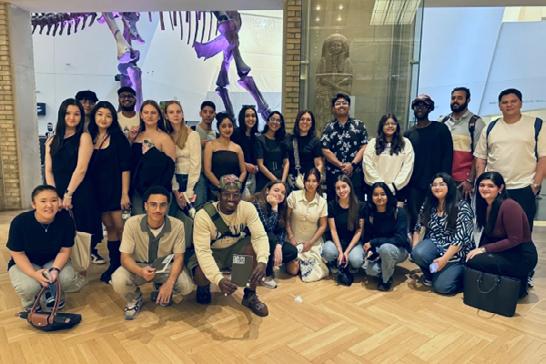
By Hanadi Alnawab
Students from the FASH 3000: 20th Century Fashion History and BUS 3003: e-Business Information Systems and Technologies courses came together for a unique learning experience at the Royal Ontario Museum (ROM) in Fall 2024. Led by professors Francesca D’Angelo and Hanadi Alnawab, the evening centred on the intersection of UX design and museum curation, offering a blend of fashion history and digital innovation.
The event started with a session from Dr. Sarah Fee, Senior Curator of Global Fashion and Textiles at the ROM. Dr. Fee shared her extensive knowledge of museum curation and provided students with valuable insights into the specific needs and considerations required for designing a museum app.
As the evening progressed, students delved into the world of UX design, exploring how history and museum exhibits shape user experience. This immersive session also introduced them to the first phase of the Design Thinking process, preparing them to create their own app prototype for the Humber Fashion History Museum. Inspired by their visit to Canada’s largest museum, the design will reflect insights gained during the field trip.
The Fashion History project is a collaborative initiative between the Fashion Management and Digital Business Management programs. It highlights the growing synergy between traditional museum curation and modern digital experiences, positioning students at the forefront of this evolving field.
In the Spring 2025 semester, students in the DIGI 3502 Database Systems course built a database for the Fashion History Museum in collaboration with Fashion Management Program Coordinator Francesca D’Angelo, with support from our Business Librarian Caleb Domsy and Library Archives Technician Shernett Bennett.
The database can be accessed on the Fashion History project website. More information about the project can be found in the LinkedIn post .
An earlier version of this article was published by the Longo Faculty of Business
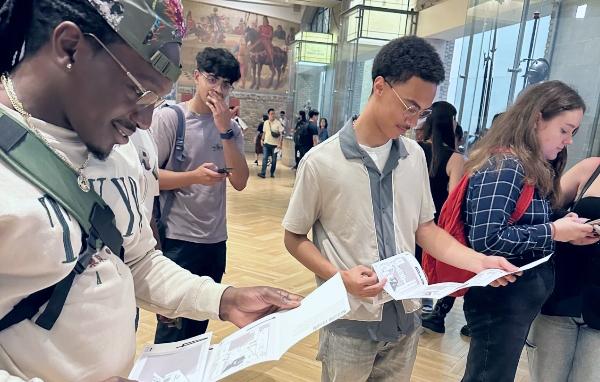


By Susan Kates
Business Management – Entrepreneurial
Enterprise students at Humber’s Downtown Campus (International Graduate School) completed their capstone projects, partnering with incredible startup companies. This capstone experience was not only an academic milestone but also a hands-on opportunity for students to immerse themselves in real-world business challenges alongside innovative partners such as:
x EcoStretch Safari: a children’s yoga mat with childfocused designs
x PillowCloud: a health and wellness company dedicated to providing products to enhance the sleeping experience
x Fung-ctional™ - Fungi Brews: a chaga (mushroom) based tea with health benefits
x Kelly Yefet Consulting : a Shopify expert helping businesses build their digital marketing efforts
Throughout the semester students took on the role of consultants, applying their knowledge and skills to help these startups tackle complex problems. From business model optimization to market research and product development, the students provided well-rounded, in-depth solutions. What truly set them apart, however, was their commitment to going above and beyond expectations. Not only did they conduct thorough research, but they also delivered actionable results. Some teams even built custom websites for their partners, integrating advanced technologies like animated AI to enhance their partners’ digital presence.
Beyond working with external partners, the capstone course also provided a platform for entrepreneurial-minded students to focus on their ventures. With dedicated time and guidance,
students such as Jovin Manjaly, who created a goal-setting app, Artem Korotkov, who gave distal marketing workshops and Elizabeth Ajayi, a professional photographer who wanted to start her business were able to test their concepts, gather valuable feedback, and refine their strategies in preparation for full-scale launches. This unique opportunity allowed them to blend their academic learning with practical experience, positioning them for future success in the entrepreneurial landscape.
The creativity, innovation, and dedication shown throughout the semester were truly inspiring. It was exciting to witness how students transformed theoretical knowledge into realworld impact. Their ability to craft tangible solutions not only supported their partners but also enhanced their professional growth.
As the students wrapped up the dynamic and rewarding semester, there’s no doubt that they are ready to take on new challenges. We can’t wait to see how they continue to innovate and grow, whether launching their ventures or becoming leaders in the business world. Their future looks bright, and this capstone experience has undoubtedly set the stage for even greater achievements to come.
Author note:
Susan Kates is a Professor & Program Coordinator of the Business Management-Entrepreneurial Enterprise program in the Longo Faculty of Business at Humber Polytechnic.
This article was originally published by the Longo Faculty of Business in Fall 2024.



TITLE: Think Again: The Power of Knowing What You Don’t Know
AUTHOR: Adam Grant
ABOUT: Organizational psychologist Grant is an expert on opening other people’s minds—and our own. With bold ideas and rigorous evidence, he investigates how we can embrace the joy of being wrong, bring nuance to charged conversations, and build schools, workplaces, and communities of lifelong learners. You’ll learn how an international debate champion wins arguments, a Black musician persuades white supremacists to abandon hate, a vaccine whisperer convinces concerned parents to immunize their children, and Adam has coaxed Yankees fans to root for the Red Sox.

TITLE: How Data Happened: A History from the Age of Reason to the Age of Algorithms
AUTHORS: Chris Wiggins, Matthew L Jones
ABOUT: Expanding on the popular course they created at Columbia University, Wiggins and Jones illuminate the ways in which data has long been used as a tool and a weapon in arguing for what is true, as well as a means of rearranging or defending power. Explore how data was created and curated, as well as how new mathematical and computational techniques developed to contend with that data serve to shape people, ideas, society, military operations, and economies.

TITLE: Freedom to Learn
AUTHOR: Carl Rogers
ABOUT: This is the text that championed a revolutionary approach to education that changed the way we teach our children. Now, in the Third Edition, it’s challenging the status quo with twenty years of evidence that defies current thinking. Five exciting new chapters focus on issues of importance now and in the future - learning from children who love school; researching person-centred issues in education; developing the administrator’s role as a facilitator; building discipline and classroom management with the learner; and personcentred views of transforming schools.

TITLE: Filterworld: How Algorithms Flattened Culture
AUTHOR: Kyle Chayka
ABOUT: Chayka shows us how online and offline spaces alike have been engineered for seamless consumption, becoming a source of pervasive anxiety in the process. Users of technology have been forced to contend with data-driven equations that try to anticipate their desires—and often get them wrong. What results is a state of docility that allows tech companies to curtail human experiences—human lives—for profit. But to have our tastes, behaviours, and emotions governed by computers, while convenient, does nothing short of calling the very notion of free will into question.

1. the activity of getting knowledge.
2. the process of getting an understanding of something by studying it or by experience.
“There is no end to education. It is not that you read a book, pass an examination, and finish with education. The whole of life, from the moment you are born to the moment you die, is a process of learning.”
—Jiddu Krishnamurti, philosopher and orator
Rebus Puzzle
A rebus is a puzzle device that combines the use of illustrated pictures with individual letters to depict words or phrases. Stretch your mind and give these puzzles a try.

We learn more from people who challenge our thought process than those who affirm our conclusions. Strong leaders engage their critics and make themselves stronger. Weak leaders silence their critics and make themselves weaker. This reaction isn’t limited to people in power. Although we might be on board with the principle, in practice we often miss out on the value of a challenge network.
Adam M. Grant, Think Again: The Power of Knowing What You Don’t Know
You are braver than you believe, stronger than you seem and smarter than you think.
A.A. Milne, author
Life is not a problem to be solved, but a reality to be experienced.
Søren Kierkegaard, theologian and philosopher
Keep going, don’t look back, and if you have an idea, just do it; no one is going to wait for you or tell you what to do.
Autumn Peltier, Anishinaabe Indigenous rights advocate
Never let the fear of striking out stop you from playing the game.
Babe Ruth, baseball player
Learn from yesterday. Live for today. Hope for tomorrow.
Albert Einstein, theoretical physicist
It always seems impossible until it’s done.
Nelson Mandela, activist and former President of South Africa
Go confidently in the direction of your dreams. Live the life you have imagined.
Henry David Thoreau, naturalist and essayist

JIPE’s Call for Papers for special issues
“Empowering Futures: Exploring Community Collaborations in Shaping Education, Industry, and Employability ” and “Measuring the Impact of Social Innovation: Evaluating Change in a Dynamic World ” are now closed.

We look forward to announcing the issues when they are complete.
Visit jipe.ca to read our latest articles.
Innovative Learning at Humber is dedicated to advancing teaching and learning practices with a focus on belonging, innovation, and sustainability. We support faculty in designing and delivering high-quality, student-centered learning experiences that integrate industry expertise and prepare learners for evolving workplaces and societal needs.
We collaborate with faculty across campuses and disciplines to develop and support teaching and learning research projects, fostering inquiry and impactful innovations in education.
For a list of current offerings, visit the Innovative Learning website.


Innovative Learning invites Humber faculty and staff to our annual SHOWCASE event celebrating teaching and learning innovations.
Date: Thursday, June 5, 2025
Location: Lakeshore Campus

This year’s SHOWCASE theme, Building Brilliance, encourages us to reflect, rethink and enhance the way we teach, collaborate, and create meaningful change in education.
SAY HI TO US SHOWCASE!ATHumber Press and Humber Literary Review will have an exhibit table set up at Showcase!
Join us for this full day conference which includes Innovation of the Year Award presentations, keynote address by Dane Jensen, variety of sessions and exhibits showcasing the work within the Humber community, and a closing reception.
Visit the Showcase website for more information and to register.

“All this plastic would have ended up in landfill, and it was garbage. To be able to see it being utilized like this is beautiful.”
—SAKSHAM SHARMA, CREATIVE DIRECTOR AT PLASTIC FLUX AND ALUMNUS OF HUMBER’S BACHELOR OF INDUSTRIAL DESIGN PROGRAM.
Read the full article, “Future-Focused Furniture: Students Showcase Eco-Friendly Chairs at Annual Design Competition” on page 30.
